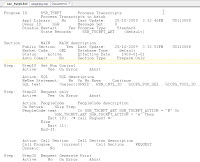 You can export an entire App Engine as text, which makes it easier to search through for any relevant code, for example where a table is used.
You can export an entire App Engine as text, which makes it easier to search through for any relevant code, for example where a table is used.1. Open the App Engine
2. File/View Report
3. File/Save Report As...
Presto.
--1 1 Key
--2 2 Duplicate Order Key
--3 4 System Maintained
--4 8 Audit Field Add
--5 16 Alternate Search Key
--6 32 List Box Item
--7 64 Descending Key
--8 128 Audit Field Change
--9 256 Required
--10 512 Translate Table Edit
--11 102 Audit Field Delete
--12 2048 Search Key
--13 4096 Reasonable Date Edit
--14 8192 Yes/No Edit
--15 16384 Prompt Table Edit
--16 32768 Auto-Update
--17 65536 Unknown
--18 131072 Unknown
--19 262144 From Search Field
--20 524288 Through Search Field
--21 1048576 1/0 Table Edit
--22 2097152 Disable Advanced Search Options
--23 4194304 Unknown
--24 8388608 Unknown
--25 16777216 Default Search Field
--26 33554432 Unknown
--27 67108864 Unknown
--28 134217728 Unknown
--29 268435456 Search Edit
--30 536870912 Unknown
--31 1073741824 Unknown
SELECT A.FIELDNAME
FROM PSRECFIELDDB A
-- Oracle: WHERE bitand(A.USEEDIT, 512) > 0
-- SQL Server: WHERE A.USEEDIT & 512 > 0
-- DB2: WHERE (USEEDIT/512)/2 <> (USEEDIT/512)/2.0.
WHERE (USEEDIT/512)/2 <> (USEEDIT/512)/2.0.
AND A.FIELDNAME not in (SELECT FIELDNAME FROM PSXLATITEM)
GROUP BY A.FIELDNAME
ORDER BY A.FIELDNAME
REM - Use this code to output both XSD and XML files;
REM - for use in the design phase;
If SSF_INVP_AET.SSF_OUTPUT_XML = "X" Or
SSF_INVP_AET.SSF_OUTPUT_XML = "B" Then
&oDS = create PSXP_XMLGEN:RowSetDS();
&MYFILE = GetFile(RTrim(SSF_INVP_AET.JF_FILE_DIR) | SSF_INVP_AET.PROCESS_INSTANCE | "_*" | ".xsd", "N", "UTF8", %FilePath_Absolute);
If &MYFILE.IsOpen Then
&sResult = &oDS.getXSDSchema(&MainChunk);
&MYFILE.WriteLine(&sResult);
&MYFILE.Close();
End-If;
&MYFILE = GetFile(RTrim(SSF_INVP_AET.JF_FILE_DIR) | SSF_INVP_AET.PROCESS_INSTANCE | "_*" | ".xml", "N", "UTF8", %FilePath_Absolute);
If &MYFILE.IsOpen Then
&sResult = &oDS.getXMLData(&MainChunk, "");
&MYFILE.WriteLine(&sResult);
&MYFILE.Close();
End-If;
End-If;
REM - End of design phase code ;
select nvl(
(select emplid from psoprdefn where oprid = 'xxx')
, 'a') from dual
Crystal Reports Print Engine error text: Error in File e:\psoft\s90dev\crw\eng\usqsf3p.rpt:This can be simply corrected by using the following steps:
Unable to connect: .rpt:
Unable to connect: incorrect log on parameters. %6 %7 %8 %9 (65,30)
Message Set Number: 65
Message Number: 30
Message Reason: Crystal Reports Print Engine error text: Error in File e:\psoft\s90dev\crw\eng\usqsf3p.rpt:
Unable to connect: .rpt:
Unable to connect: incorrect log on parameters. %6 %7 %8 %9 (65,30)




